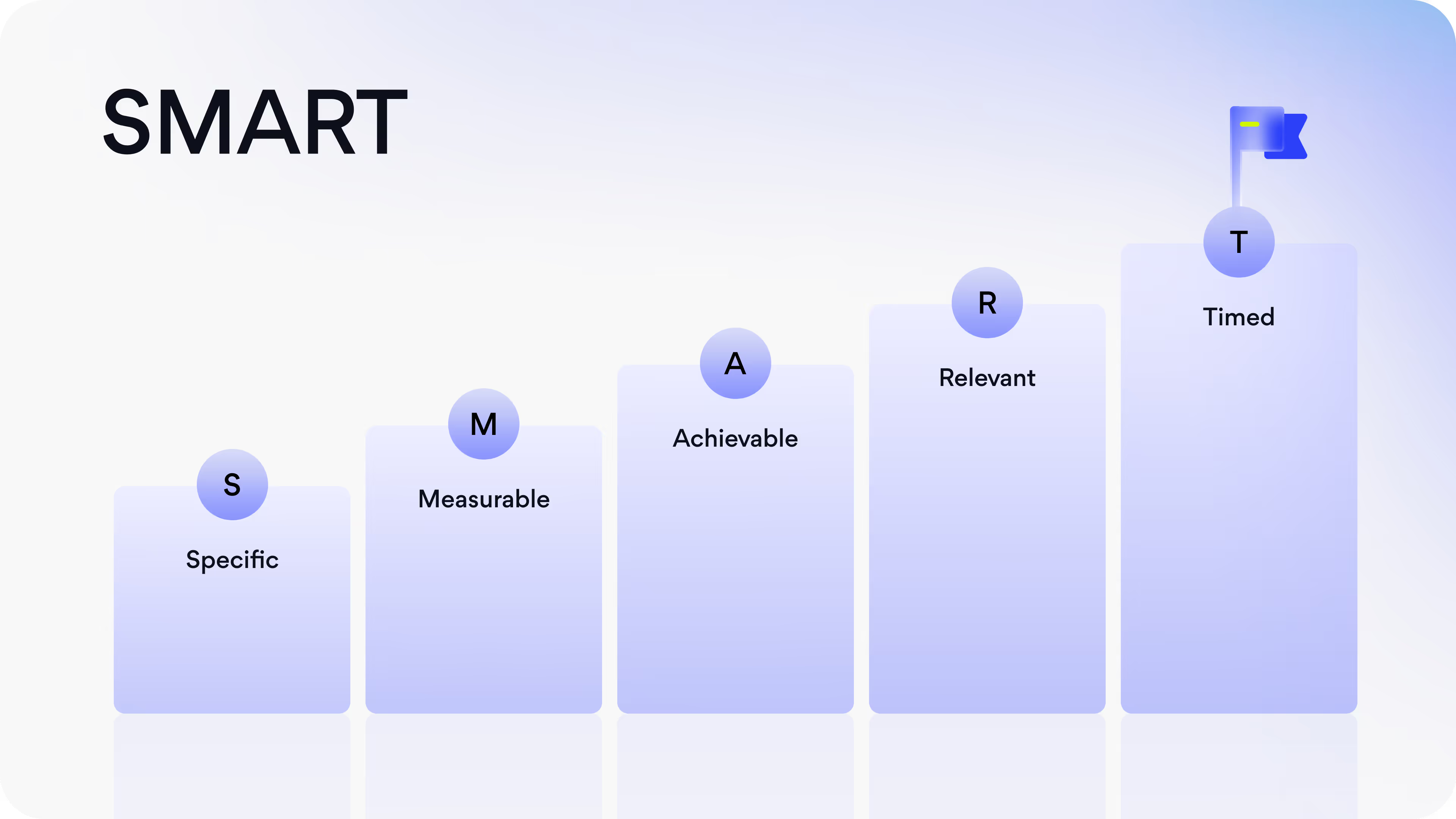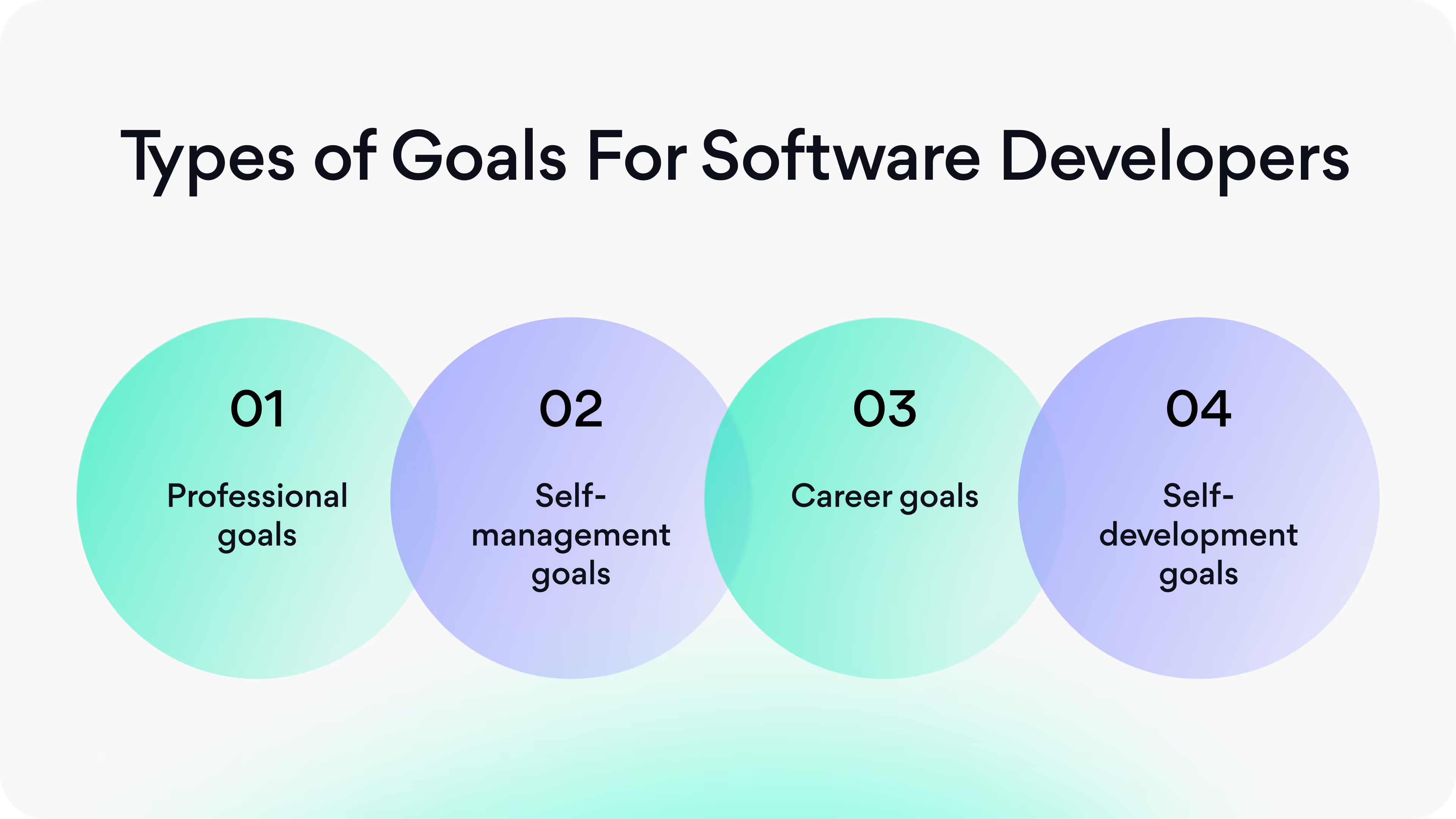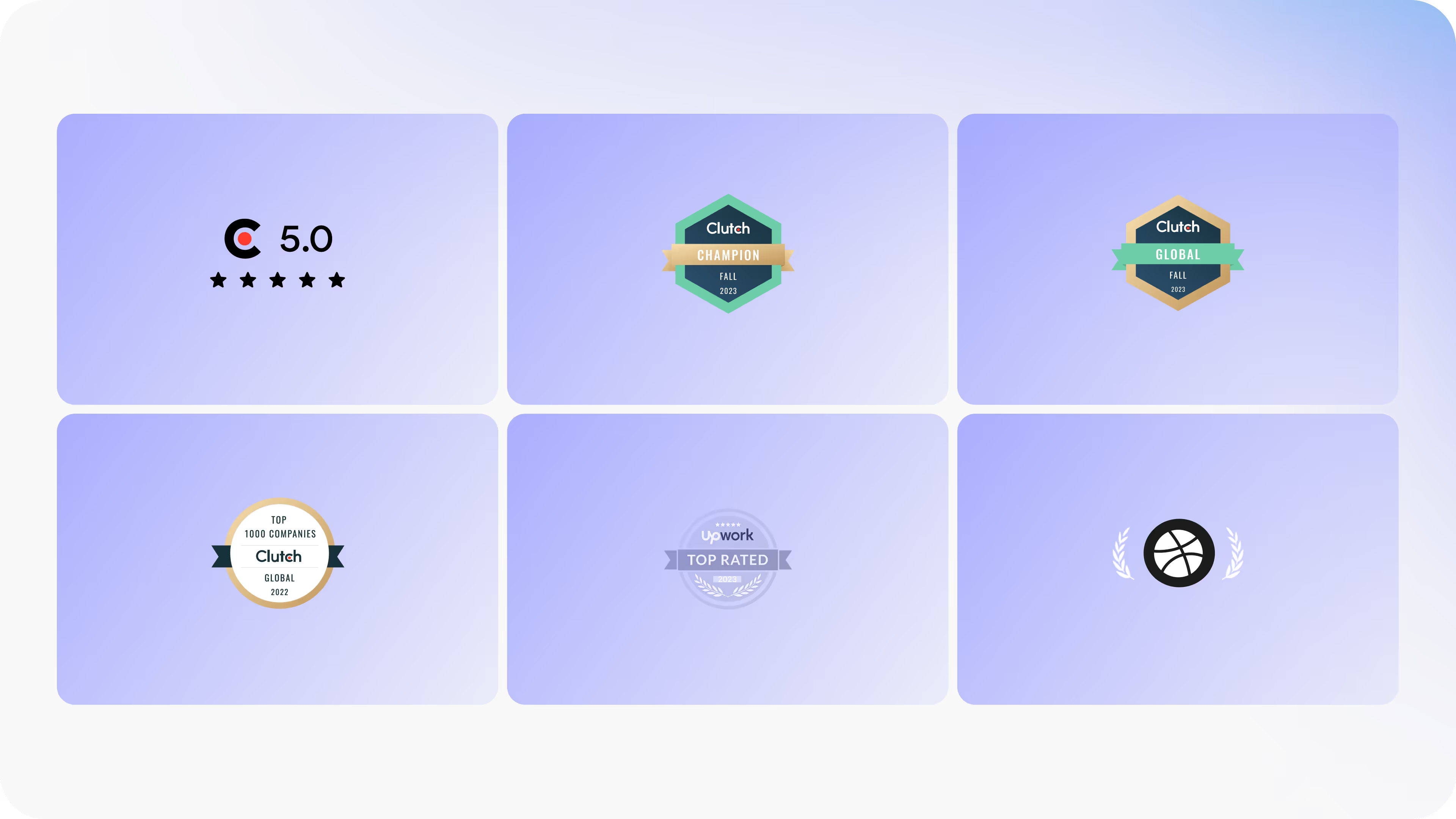If you are ready to enhance your web design with expert solutions, let’s talk!
As a software developer, do you ever feel close to burnout because of numerous goals you cannot achieve? Smart objectives are crucial in the digital realm, where the competitive edge is sharp. When you are focused and organized with your tasks, you will become highly productive, and it will help you grow in your career.
With competition being highest in the dynamic digital industry, you must have a clear goal. Organizing your workload wisely and maintaining concentration will help you increase your productivity and career growth manifold. At Arounda, our team, comprised of designers, project managers, and software developers, has tried many productivity strategies. We have delivered 250+ projects across startups and SMEs over the last 9 years, and they always come out to be one of the most helpful management tools.
This guide is not just a theoretical overview, it's a practical roadmap. It’ll review the basics and share 20 examples of long-term and short-term SMART goals for software developers, giving you the confidence and reassurance you need to apply these principles in your daily work.

Article Key Takeaways
Software developers often face the issue of vague or dispersed goals, which ultimately hinders meaningful progress and threatens performance and growth. When priorities overlap and there’s no established structure, teams can become prone to random acts of work.
The answer is to convert goals into SMART ones, which are Specific, Measurable, Attainable, Relevant, and Time-bound steps to achieve the goal. Using this approach will help developers stay on track to measure output and grow long-term while increasing daily efficiencies.
In this article, we will explore the SMART framework and provide you with 20 applicable examples designed for software developers — whether that’s technical skills or professional goals. With Arounda's 9+ years of experience and 250+ projects as a design and development agency, our team is able to add real-world perspectives that prove goal-setting principles work not only in theory but also in actual product strategy and development.
What Are SMART Goals?
Due to the advantages of defining objectives and making progress measurement easier, this type of goal is a common strategy in various industries, especially within software development. SMART method helps clarify your tasks and professional growth by structuring goals according to specific criteria. SMART consists of five conditions. And each goal must correspond to them to maximize its effectiveness. This list guides developers in setting measurable and realistic goals:
- Specific: Your goals must be clear and precise. A specific target is always easy to comprehend. Clear objectives help the developers focus on their work and see the results they want to achieve.
- Measurable: A measurable goal provides specific criteria or benchmarks for tracking progress and confirming accomplishment. Measurable metrics allow developers to keep track of their motivation levels, objectively assess their progress, fix mistakes, and alter strategies along the way.
- Attainable: Is your goal based on your available resources, skills, and conditions? Ambitious goals will stretch you, but they also need to be realistic and meaningful, both from your professional circumstance and to prevent a burnout or «I don’t want to do this anymore» syndrome.
- Relevant: This needs to align with your overall career goals and doing things with a project or career. It's not getting old but keeps helping you prioritize your many jobs and get motivation, and it makes all you do have an amazing and effective impact.
- Time-bound: Time-bound objectives are set within specific deadlines or timeframes, creating a sense of urgency and prompting ongoing progress. Defining a goal date allows you to decide the importance of each thing you have to do, maintain the discipline needed to achieve it, and avoid procrastination by having well-defined milestones.
Why Are SMART Goals Important for Software Developers?

Software development is not just a job, it's a journey of ongoing learning and adaptation. As the field evolves, so must you. This commitment to learning and execution is what sets you apart as a developer, and it's why SMART goals are so important. They keep you engaged, committed, and always striving for excellence.
Software goals can help developers become better organized, prioritize responsibilities, and remain focused on the objectives they need to achieve. They help you to chunk up big, scary projects into bite-sized bits, where each bit has a deadline and measurable result. Doing so increases not only his productivity as an individual but also his team's productivity by clarifying expectations, and establishing milestones.
Moreover, measurable goals for software developers let track their progress consistently, detect hindrances at an early stage, and get on track quickly; this greatly enhances their potential to repeat the delivery of successful projects over time. Whether you are an experience developer aiming for advanced technical skill acumen, or a new developer focused on understanding the best places to start, this kind of goals are an effective method of attaining professional achievement and excellence.
In the subsequent part, we are going to explore different examples of smart goals for software developers that include daily tasks, beginner, and high-end professional challenges.
20 SMART Goals Examples for Software Developers
Setting goals requires consistent practice. The more frequently you apply SMART goals for programmers, the more effective your goal-setting becomes.
A literally SMART goal
At the end of the day, it's a clear and straightforward statement that encompasses all five components — Specific, Measurable, Attainable, Relevant, and Time-bound- to establish a goal that is both defined and achievable. Let's examine each component to understand how they contribute to creating a goal that is clear and attainable.
1. Meet the project deadline
Goal: Finish the project in 3,5 months. Which means dedicating at least 10 hours each day, aiming for at least 33% of the project to be finished monthly, while setting aside eight extra days for unforeseen challenges.
- Specific: A well-defined objective ensures structured progress.
- Measurable: Progress can be easily monitored with daily and monthly productivity goals.
- Achievable: Spending 10 hours every day is equal to standard workload patterns, making it feasible even when acquiring new skills.
- Relevant: Adhering to project deadlines significantly impacts job performance and team dependability.
- Time-bound: Monthly targets and a final deadline establish clear progress checkpoints of evaluation.
Now, let's differentiate performance objectives for software developers into four groups.

Professional goals
Here are examples of common performance goals for software developers:
2. Coding
Goal: Complete the current project with zero critical bugs identified during the QA phase.
3. Testing
Goal: Find a solution to ⅘ of identified memory security issues by the end of April, spending at least 20% of your time each month. Starting with the most critical vulnerabilities.
4. Debugging
Goal: Finish a bug report during two working days, giving 6 hours each day to ensure clear documentation.
5. Productivity
Goal: Attain proficiency in IDE shortcuts within a month by dedicating about 40 minutes every day to tutorials and practice, considerably strenghtening coding efficiency.
Self-management Goals
Effective self-management skills boost a software developer's productivity, job satisfaction, and overall team contribution. Developers who shine in managing their own workload not only ensure the timely completion of tasks but also greatly enhance collaboration within their teams by reducing bottlenecks and clearly communicating progress.
Growing strong self-management skills involves improving time management, task prioritization, and maintaining consistent productivity levels, even when facing tight deadlines or unexpected challenges. It also includes proactively addressing obstacles and refining workflows to maximize adaptability.
Here are detailed practical examples of SMART goals for software engineers specifically designed to enhance self-management and organizational capabilities:
6. Weekly Planning
Goal: Allocate one hour every Sunday afternoon to carefully outline and schedule tasks for the upcoming week, ensuring smoother workflow management.
7. Ensure Precise Project Requirements
Goal: Proactively clarify project requirements by discussing all uncertainties with clients and supervisors before starting the development phase.
8. Improve team communication
Goal: Regularly engage with team members, seeking support when needed and proactively offering assistance, thus improving team efficiency and collaboration.
9. Hold a session
Goal: Moderate at least one team meeting each week, progressively refining meeting management skills and effectiveness.
10. Built a habit
Goal: Foster active participation by preparing thoroughly for each team meeting and contributing proactively to the meeting agendas throughout the year.
Career Goals
Software developers regularly encounter diverse challenges that significantly impact their professional growth trajectory. Navigating a career successfully in the tech industry involves not only continuous learning and technical expertise but also strategic planning, goal setting, and personal branding. Implementing a habit of programming goals provides a structured approach to career progression, fostering resilience, clarity, and sustained motivation.
Effective career goals help developers build valuable professional relationships, assume leadership roles, and increase their marketability within the technology sector. Here are comprehensive software developer performance goals examples:
11. Networking
Goal: Strengthen professional network by regularly updating LinkedIn profile and posting insightful content weekly, expanding connections within the tech industry.
12. Leadership
Goal: Offer regular mentorship to a junior developer, dedicating two hours weekly to guide and develop their professional skills.
13. Teamwork
Goal: Integrate Gantt chart functionality into our current project management software within this quarter to enhance team coordination and productivity.
14. Responsibility
Goal: Successfully lead and complete a new project on time, producing significant outcomes and advancing project management capabilities.
15. Money
Goal: Reach a monthly income goal of $3K by actively exploring promotion opportunities, seeking additional projects, and engaging in relevant professional training.
Self-development Goals
As a software developer, you need to keep growing personally and professionally in an ever-growing industry. With clear, measurable targets, developers can incrementally grow their skill stacks, adaptation markets, and career options.
Self-development is an active and goal-oriented process focused on growth, backing up the progress of skills and capabilities. By setting clear, achievable objectives, developers can systematically enhance their skill sets, adaptability, and career prospects. Here are detailed, actionable SMART goals for developers examples, with examples aimed at fostering continuous personal and professional growth:
16. Learning
Goal: Join an annual curriculum on platforms like Coursera or Udemy. Cover new programming languages and other skills crucial to you.
17. Presentation skills
Use a dynamic presentation tool such as Prezi or Canva for the next project presentation. Dedicate a minimum of two hours before the presentation. Understand software and practice.
18. Freelance
Goal: Take up a freelance project that’ll help to boost communication skills, diversify professional experiences, and generate additional income. Should update Upwork profile this week and actively seek suitable projects daily.
19. Language
Goal: Learn fifteen new foreign vocabulary words a week using Quizlet, implementing short revision sessions during daily breaks.
20. Inspiration
Goal: Attend at least one software development conference each year to stay up to date on new industry trends and gain inspiration from the speakers.
All-purpose SMART Goals For A Software Developer
A software developer faces daily challenges that test intelligence and personal discipline. Mastering the SMART technique can help you navigate these obstacles. This method is versatile, applying equally well to professional growth, career advancement, self-management, and personal development.
At Arounda, we embrace these objectives in all our projects, whether developing mobile and web apps, crafting engaging UI/UX designs, or conducting comprehensive business analyses for our clients. Our commitment to this method supports our continuous improvement and success, earning recognition by Clutch as one of the leading agencies for Ukraine’s UX design industry.

Got a project? Our team will carefully study your task and suggest the best solution for your business. Tell us more about your idea at info@arounda.agency.














